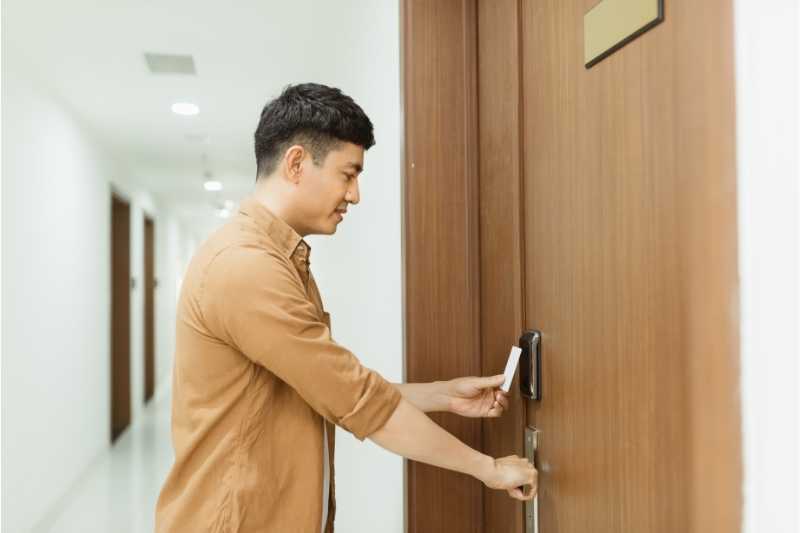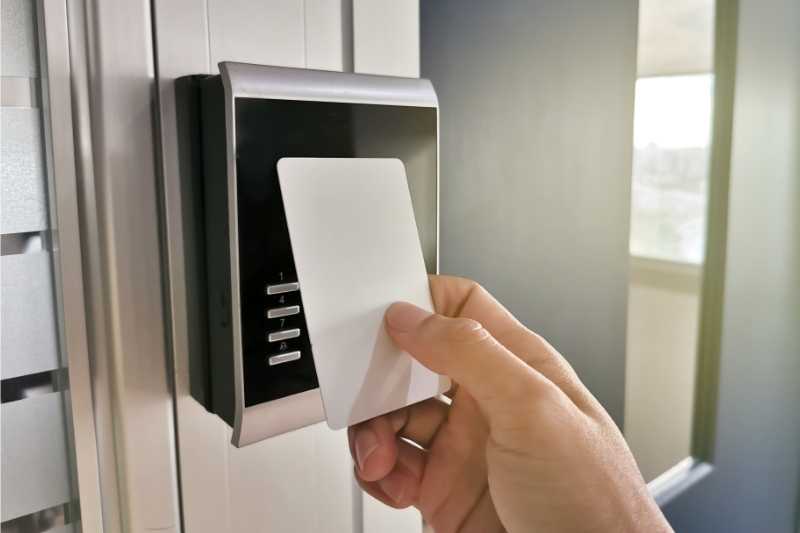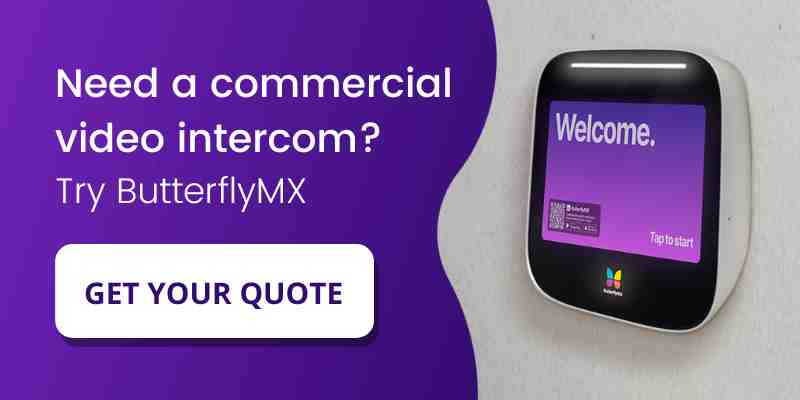Key takeaways
- Card reader door locks use RFID technology to scan key cards and electronically open door locks. They scan information stored on key cards and open if the credentials are authorized.
- Advantages include user-friendliness, lenience towards lost or forgotten cards, and easy installation.
- The disadvantages are that users still have to carry key cards, are susceptible to fraud, and can be easily lost.
- Overall, card reader door lock systems are an effective security system for your building.

Improving security at your property requires the right tools. With so many solutions available — from traditional key card door locks to robust mobile access control systems — how do you narrow down your options? The card reader door lock is one solution that might be right for you. But every building’s security needs are different, so it’s important to know exactly how it can improve your building.
In this post, we go over what a card reader with a door lock is, how it works, and how much commercial card door lock systems cost. Then, we review the pros, cons, and alternatives for card reader door locks. Finally, we explain the best way to use them on your property.
This post covers:
- What is a card reader door lock?
- How does a card reader lock for doors work?
- Pros and cons of card reader locks
- Alternatives to card reader door locks
- Best way to use key card reader locks
What is a card reader door lock?
A card reader lock is a credential-reading door lock that can be opened with a key card. You can choose between electronic and magnetic card reader door lock options.
Keyless entry systems are among the most popular because they’re quick to install and have easy-to-program credentials. However, they’re most commonly found in commercial properties such as hotels.
Residential or commercial card reader door locks can be installed in places such as:
- Building entryways
- Staff-only areas
- Laundry rooms
- Fitness centers and recreation rooms
- Package rooms
- Residential units
- Hotel rooms
Pro tip: Order numerous cards for your building’s staff and residents, then easily program them to match only specific card readers. For example, you can program a staff-only area’s card reader door lock to only respond to staff member credentials.
How does a card reader door work for doors?
Card readers use RFID door lock (Radio Frequency IDentification) technology to communicate with a key card.
The proximity card reader door lock identifies the key card by its magnetic stripe or PIN. Next, the RFID card reader verifies this information. If the card’s credentials match, the card reader releases the door-locking mechanism.
How do I use a card reader door lock?
- A user swipes their card through the reader or holds it against the reader’s scanner.
- The reader processes the magnetic stripe along the back of the card or its RFID tag to verify the credentials.
- The electronic lock is released, and the door can be opened.

What are the different types of card reader door locks?
As noted, card reader locks for doors can be magnetic or electronic. While they’re both technically electronic, one relies on magnetic plates and the other on electric strikes.
Magnetic door locks with card readers use a magnetic plate to keep the door locked. They’re commonly found in glass doors or gates that can’t support transfer wires through hinges or strike plates.
Conversely, electronic card readers for doors use electric strikes that latch the door in place with a hinged piece of metal. When the lock receives an electrical signal from the card reader, it moves the metal piece, allowing the door to open.
Components of card reader locks for doors:
- Key card. The access credentials that replace the common key.
- Electronic door lock. The component that utilizes RIFD technology to lock the door electronically.
- Card reader. This is the exterior device attached to the door that scans the key card and approves the release of the electronic door lock.
How much do card reader door locks cost?
Key card reader and door lock systems cost between $300 and $1,200, which is in the mid-price range compared to similar commercial door locks.
Pros and cons of card reader locks
Card reader locks can have a wide variety of uses on your property. But what are the advantages of RFID door locks, and what other factors should you consider? Before you purchase one for your property, consider the card reader’s pros and cons.
Pros:
- Key cards and fobs can be replaced more easily than traditional keys.
- Key cards are much less burden than physical keys — users can even carry them in their wallets.
- Key card door lock installation is quick and easy.
- Hours of use can be programmed into the card reader, keeping people out of restricted areas after hours.
- Missing key cards can be remotely deactivated.
- Key cards can be reused.
- Swipe key cards can be tracked. That way, you know who entered through each card reader lock at a certain time.
Cons:
- Criminals can steal key cards and use them.
- Although they’re easier to track than traditional keys, residents can still forget or lose their key cards.
- Key cards don’t entirely replace traditional lock-and-key systems and still require users to carry and care for a physical key.
- Replacing lost key cards adds up over time.
Check out how the ButterflyMX keypad works:
Alternatives to card reader door locks
We can safely conclude that keyless electronic RFID reader door locks are much more robust than your typical lock-and-key system. Of course, they are far from the only commercial door lock system that may work for your building.
Commercial smart locks are a more tech-savvy alternative to card reader locks.
Smart locks are electromechanical locking systems that can be opened with a smartphone. Users download an app and gain entry with just a finger tap. Alternatively, they can enter via a unique PIN code from their phone.
Alternatives to RFID card reader locks include:

1. Keypads
Keypads are convenient because they don’t require physical credentials. Your staff will no longer have to spend time on key management or reprogramming new keys for residents who’ve lost theirs.
Plus, modern keypads come with time-saving features like temporary codes and integrations with smartphone apps for mobile access.
2. Fob readers
Fobs are quite similar to keys regarding the wireless technology they depend on. But they’re generally smaller when comparing them to cards, which has benefits and drawbacks for residents.
Residents are more likely to lose a smaller fob, which increases costs as you replace them. But, residents can more easily attach a fob to a ring of keys or something similar and keep track of it that way.
3. Biometric ID
A biometric ID system uses your resident’s physical characteristics, such as their fingerprint or a scan of their eye or face, as credentials.
Biometric door lock security has a few benefits—it’s incredibly secure, and there’s no chance of a resident losing or forgetting a biometric credential. However, it’s an expensive security option, and it’s especially sensitive to weather events like heavy rain or snow.
Best way to use key card reader locks
The best way to use card reader door locks is as part of a larger security ecosystem that includes intercoms, keypads, and other hardware that fits your property’s security needs.
Card readers are a simple, convenient solution that simplifies residents’ entry and staff’s workloads. However, even the best card reader door lock systems have drawbacks. They shouldn’t be the sole access control system that your property depends on.
A security solution that fits one entryway won’t always be the best fit for another. Only you know how to secure your property and your residents best — but with ButterflyMX’s suite of access control products, you’ll get all the help you need.
Benefits of ButterflyMX include:
- Unified access ecosystem. Fit the unique security needs of your property by choosing from our suite of intercoms, elevator controls, keypads, vehicle access systems, and more. These products and our third-party integrations enable property-wide access so that you can manage access to your entire property from a single location, saving you time and money.
- Integrations. We integrate with dozens of the most popular providers of security cameras, property management systems, and smart locks. Add your preferred technology to our system, or seamlessly integrate your existing security systems with our products—and manage everything from the powerful ButterflyMX OS.
- Cloud-based management. Make changes, edit permissions, and review an audit trail of all door entry events — from any smartphone, tablet, or laptop, whether you’re on- or offsite. This way, you can manage multiple properties on the go or enable a remote team to manage access at your properties.






